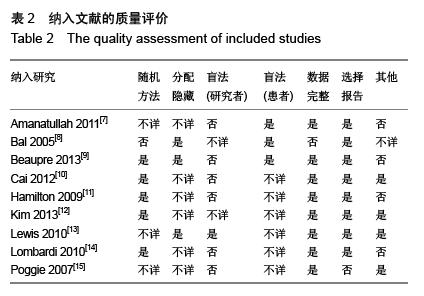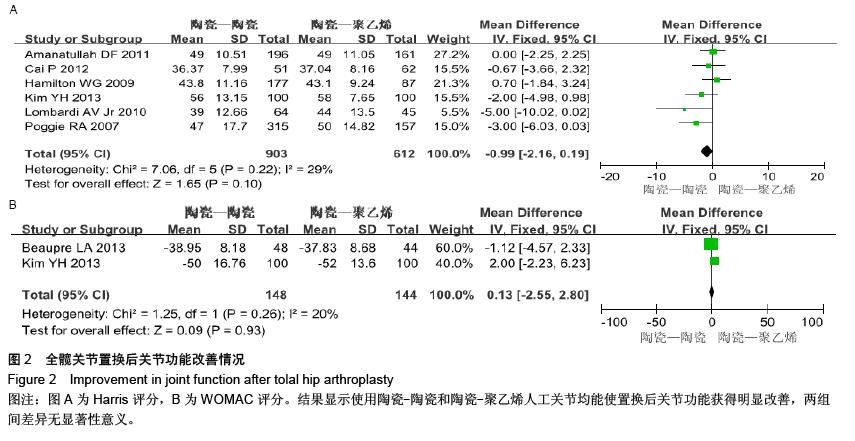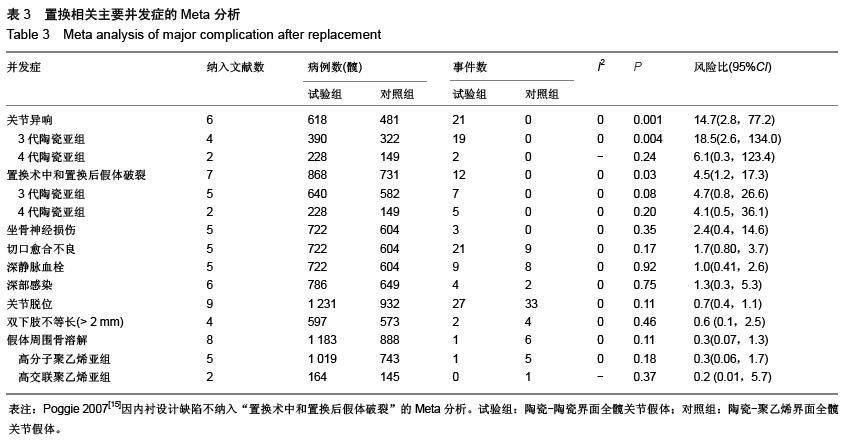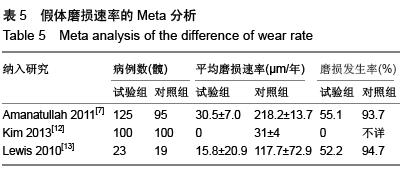| [1] Rajpura A, Kendoff D, Board TN. The current state of bearing surfaces in total hip replacement. Bone Joint J. 2014;96-b(2): 147-156.
[2] 徐步国, 严世贵.人工髋关节假体摩擦界面的进展[J].中国骨与关节外科, 2013, 6(z1):66-69.
[3] 曾建春,曾意荣,樊粤光,等.第四代陶对陶全髋关节置换术后陶瓷头碎裂翻修[J]. 中华关节外科杂志(电子版), 2013, 7(5): 95-97.
[4] Allain J, Roudot-Thoraval F, Delecrin J, et al. Revision total hip arthroplasty performed after fracture of a ceramic femoral head. A multicenter survivorship study. J Bone Joint Surg. 2003;85-a(5):825-830.
[5] Francesco T, Enrico T, Marcello DF, et al. Revision of ceramic hip replacements for fracture of a ceramic component: AAOS exhibit selection. J Bone Joint Surg. 2011;93(24):e147.
[6] Hu D, Kai T, Xiao Y, et al. Comparison of ceramic-on-ceramic to metal-on-polyethylene bearing surfaces in total hip arthroplasty: a meta-analysis of randomized controlled trials. J Orthop Surg Res. 2015;10(1):22.
[7] Amanatullah DF, Landa J, Strauss EJ, et al. Comparison of surgical outcomes and implant wear between ceramic-ceramic and ceramic-polyethylene articulations in total hip arthroplasty. J Arthroplasty. 2011;26(6 Suppl):72-77.
[8] Bal BS, Aleto TJ, Garino JP, et al. Ceramic-On-Ceramic Versus Ceramic-On-Polyethylene Bearings In Total Hip Arthroplasty: Results Of A Multicenter Prospective Randomized Study And Update Of Modern Ceramic Total Hip Trials In The Usa. Bioceram Alt Bear Joint Arthroplasty. 2005; 15(3):101-108.
[9] Beaupre LA, Manolescu A, Johnston DW. A randomized trial of ceramic-on-ceramic bearing versus ceramic-on- crossfire-polyethylene bearing in total hip arthroplasty: five-year outcomes. J Arthroplasty. 2013;28(3): 485-489.
[10] Cai P, Hu Y, Xie J. Large-diameter Delta ceramic-on-ceramic versus common-sized ceramic-on-polyethylene bearings in THA. Orthopedics. 2012;35(9):e1307-e1313.
[11] Hamilton WG, Mcauley JP, Dennis DA, et al. THA with Delta ceramic on ceramic: results of a multicenter investigational device exemption trial. Clin Orthop Relat Res. 2010; 468(2): 358-366.
[12] Kim YH, Park JW, Kulkarni SS, et al. A randomised prospective evaluation of ceramic-on-ceramic and ceramic-on-highly cross-linked polyethylene bearings in the same patients with primary cementless total hip arthroplasty. Int Orthop. 2013;37(11):2131-2137.
[13] Lewis PM, Al-Belooshi A, Schemitch EH, et al. Prospective randomized trial comparing alumina ceramic-on-ceramic with ceramic-on-conventional polyethylene bearings in total hip arthroplasty. J Arthroplasty. 2010; 25(3):392-397.
[14] Lombardi AV Jr, Berend KR, Seng BE, et al. Delta ceramic-on-alumina ceramic articulation in primary THA: prospective, randomized FDA-IDE study and retrieval analysis. Clin Orthop Relat Res. 2010;468(2):367-374.
[15] Poggie RA, Turgeon TR, Coutts RD. Failure Analysis of a Ceramic Bearing Acetabular Component. J Bone Joint Surg. 2007;89(2):367-375.
[16] 魏丽娟, 董惠娟. Meta分析中异质性的识别与处理[J]. 第二军医大学学报, 2006, 27(4):449-450.
[17] Ahmad MA, Xypnitos FN, Giannoudis PV. Measuring hip outcomes: common scales and checklists. Injury. 2011;42(3): 259–264.
[18] Liebs TR, Herzberg W, Gluth J, et al. Using the patient's perspective to develop function short forms specific to total hip and knee replacement based on WOMAC function items. Bone Joint J. 2013.
[19] Stanat SJ, Capozzi JD. Squeaking in Third- and Fourth- Generation Ceramic-on-Ceramic Total Hip Arthroplasty. J Arthroplasty. 2012; (3):445-453.
[20] Weisse B, Affolter C, Terrasi GP, et al. Failure analysis of in vivo fractured ceramic femoral heads. Eng Fail Anal. 2009;16: 1188-1194.
[21] Jeffers JR, Walter WL. Ceramic-on-ceramic bearings in hip arthroplasty: state of the art and the future.J Bone Joint Surg Br. 2012;94(6):735-745.
[22] Willmann G. Ceramic femoral head retrieval data. Clin Orthop Relat Res. 2000;379:22-28.
[23] Tateiwa T, Clarke IC, Williams PA, et al. Ceramic total hip arthroplasty in the United States: safety and risk issues revisited. Am J Orthop. 2008;37(2):E26-E31.
[24] Massin P, Lopes R, Masson B, et al. Does Biolox® Delta ceramic reduce the rate of component fractures in total hip replacement? Orthop Traumatol Surg Res.2014; 100(6Suppl): S317-S321.
[25] Kircher J, Bader R, Schroeder B, et al. Extremely high fracture rate of a modular acetabular component with a sandwich polyethylene ceramic insertion for THA: a preliminary report. Arch Orthop Trauma Surg. 2009;129(9): 1145-1150.
[26] Ha YC. High Rate of Ceramic Sandwich Liner Fracture. Clin Orthop Relat Res. 2012;470(11):3263.
[27] Stroh DA, Issa K, Johnson AJ, et al. Reduced dislocation rates and excellent functional outcomes with large-diameter femoral heads. J Arthroplasty. 2013;28(8):1415–1420.
[28] Philippe H, Yasuhiro H, Olivier P, et al. Ceramic-on-ceramic Bearing Decreases the Cumulative Long-term Risk of Dislocation. Clin Orthop Relat Rese. 2013; 471(12): 3875-3882.
[29] Leichtle UG, Leichtle CI, Taslaci F, et al. Dislocation after total hip arthroplasty: risk factors and treatment options. Acta Orthopaedica Et Traumatologica Turcica. 2013;47(2):96-103.
[30] Diana B, Javad P. Biological response to prosthetic debris. World J Orthopedics. 2015;6(2):172-189.
[31] Kurtz SM, Gawel HA, Patel JD. History and systematic review of wear and osteolysis outcomes for first-generation highly crosslinked polyethylene. Clin Orthop Relat Res. 2011;469(8): 2262-2277.
[32] Harsha AP, Joyce TJ. Comparative wear tests of ultra-high molecular weight polyethylene and cross-linked polyethylene. Proc Instit Mechan Eng. 2013; 227(5):600-608.
[33] Dumbleton JH, Manley MT, Edidin AA. Aliterature review of the association between wear rate and osteolysis in total hip arthroplasty. J Arthroplasty. 2002; 17(5):649-661.
[34] Shen C, Tang ZH, Hu JZ, et al. Does cross-linked polyethylene decrease the revision rate of total hip arthroplasty compared with conventional polyethylene? A meta-analysis. Orthop Traumatol Surge Res. 2014;100(7): 745-750. |
.jpg)
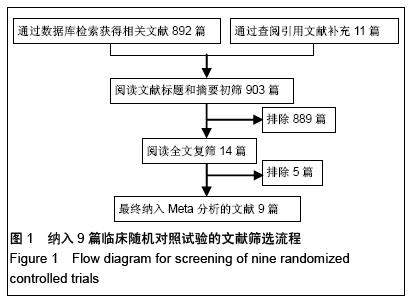
.jpg)
